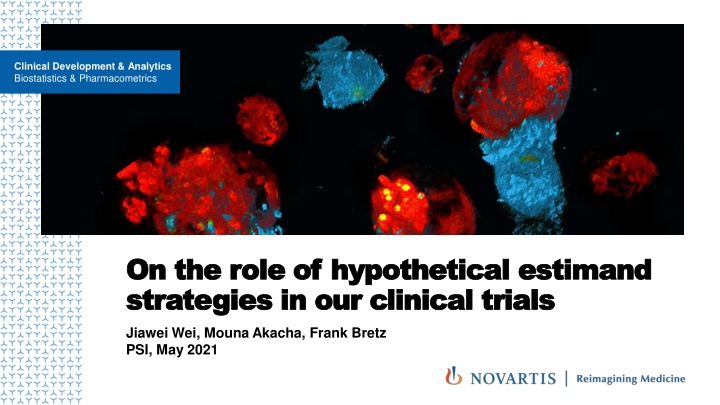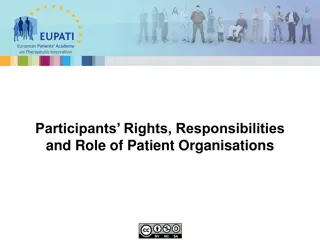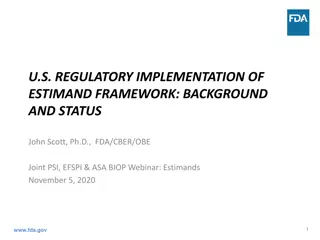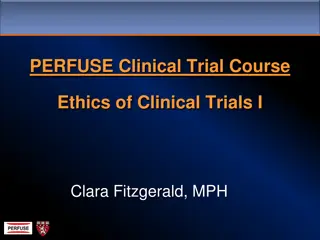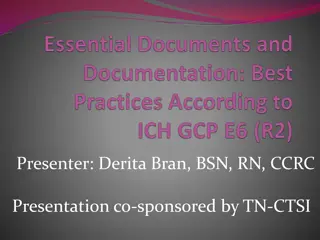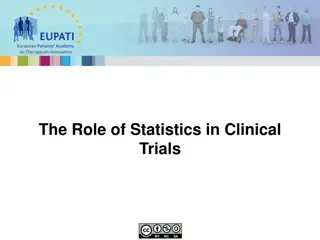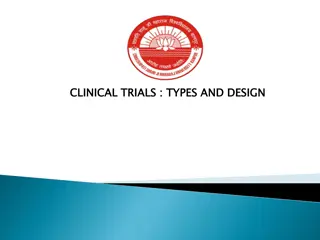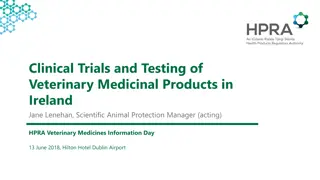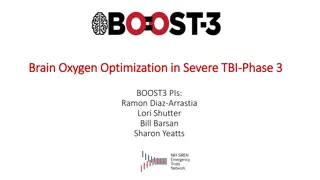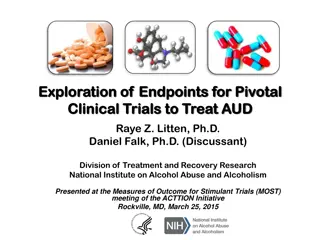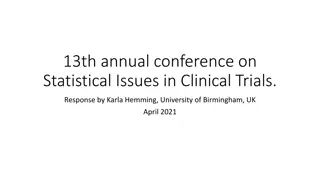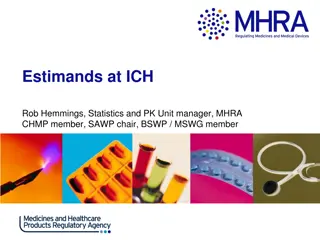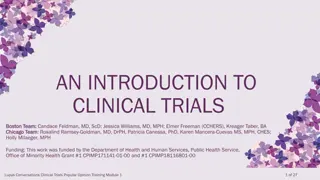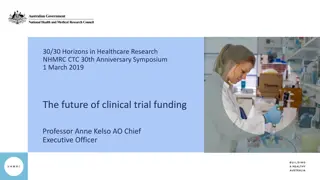Role of Hypothetical Estimand Strategies in Clinical Trials
Hypothetical estimand strategies play a crucial role in clinical trials as they help define scenarios that impact variables of interest. Clear and precise wording is essential to avoid ambiguity when formulating these hypothetical scenarios. Examples of hypothetical scenarios include evaluating the treatment effect if certain events had not occurred. Broad ranges of hypothetical scenarios can be considered, each requiring specific language to ensure clarity and relevance in clinical trial design.
Download Presentation

Please find below an Image/Link to download the presentation.
The content on the website is provided AS IS for your information and personal use only. It may not be sold, licensed, or shared on other websites without obtaining consent from the author.If you encounter any issues during the download, it is possible that the publisher has removed the file from their server.
You are allowed to download the files provided on this website for personal or commercial use, subject to the condition that they are used lawfully. All files are the property of their respective owners.
The content on the website is provided AS IS for your information and personal use only. It may not be sold, licensed, or shared on other websites without obtaining consent from the author.
E N D
Presentation Transcript
Clinical Development & Analytics Biostatistics & Pharmacometrics On the role of hypothetical On the role of hypothetical estimand strategies in our clinical trials strategies in our clinical trials Jiawei Wei, Mouna Akacha, Frank Bretz PSI, May 2021 estimand
Hypothetical strategies Hypothetical strategies What if... What if... According to ICH E9(R1): A scenario is envisaged in which the intercurrent event would not occur: the value of the variable to reflect the clinical question of interest is the value which the variable would have taken in the hypothetical scenario defined. A wide variety of hypothetical scenarios can be envisaged, but some scenarios are likely to be of more clinical or regulatory interest than others. This results in a VERY broad class of estimands, examples include: Effect if rescue medication had not been available Effect if treatment switching would not have been allowed Effect if all patients had adhered to their treatment regimen Effect if the COVID-19 pandemic had not resulted in drug supply issues 2 | CD&A | Analytics | Business Use Only
Precise wording is crucial Precise wording is crucial According to ICH E9 (R1): If a hypothetical strategy is proposed, it should be made clear what hypothetical scenario is envisaged. For example, wording such as if the patient does not take additional medication might lead to confusion as to whether the patient hypothetically does not take additional medication because it is not available or because the particular patient is supposed not to require it. Multiple hypothetical strategies exist and a precise language is needed to avoid ambiguity, e.g. What would the treatment effect be,... ... had rescue meds not been made available? ... had patients not needed rescue meds and behaved like other patients who did not take rescue meds? | CD&A | Analytics | Business Use Only ... had patients not needed rescue meds and behaved like placebo patients? 3
Broad range hypothetical scenarios Broad range hypothetical scenarios can be considered can be considered What is the treatment effect if rescue meds were not taken? Is this precise enough? What would the treatment effect be, had rescue meds not been made available? May be plausible to ask this question if rescue was optional Presumably patients would have more severe symptoms if rescue was withheld What would the treatment effect be, had patients not needed rescue meds and behaved like other patients who did not take rescue meds? Not clear what plausible scenario would lead to patients not needing rescue Not clear why patients who needed rescue would behave like patients not needing rescue What would the treatment effect be, had patients not needed rescue meds and behaved like placebo patients? Not clear what plausible scenario would lead to patients not needing rescue Not clear why patients who needed rescue would behave like placebo patients thereafter 4 | CD&A | Analytics | Business Use Only
Broad range hypothetical scenarios Broad range hypothetical scenarios can be considered can be considered What is the treatment effect if rescue meds were not taken? Is this precise enough? What would the treatment effect be, had rescue meds not been made available? May be plausible to ask this question if rescue was optional Presumably patients would have more severe symptoms if rescue was withheld Importantly, speaking of THE hypothetical leaves too much room for ambiguity a precise language is required. What would the treatment effect be, had patients not needed rescue meds and behaved like other patients who did not take rescue meds? Not clear what plausible scenario would lead to patients not needing rescue Not clear why patients who needed rescue would behave like patients not needing rescue Numerous hypothetical estimands can be formulated some of which are more useful and clinically plausible than others. What would the treatment effect be, had patients not needed rescue meds and behaved like placebo patients? Not clear what plausible scenario would lead to patients not needing rescue Not clear why patients who needed rescue would behave like placebo patients thereafter 5 | CD&A | Analytics | Business Use Only
Good and bad hypotheticals Good and bad hypotheticals Good hypotheticals Scenarios that change the study design might be of regulatory interest For example: it may be plausible to consider a scenario where treatment switching was not possible in placebo controlled trials Bad hypotheticals Scenarios that change the patients behaviors might not be of regulatory interest, this holds in particular for scenarios that cannot possibly occur in clinical practice For example: it may not be reasonable to hypothesize a scenario where patients fully adhere to their treatment notwithstanding serious adverse events General consideration to help distinguish between good and bad hypotheticals Can you intervene on the intercurrent event, or not? If you can, then it might be of clinical (and regulatory?) interest, otherwise if you cannot intervene then the hypothetical strategy will usually not be of interest. 6 | CD&A | Analytics | Business Use Only
Regulatory perspectives Regulatory perspectives 1 1 Ongoing scientific discussions with regulators: Hypothetical strategy is controversial Some believe commonly used hypothetical estimands are not meaningful to patients or providers and therefore also not meaningful to regulators Some believe hypothetical estimand could be useful (e.g. in the setting of the COVID-19 pandemic), but the choice must be balanced with the ability to estimate the estimand reliably and robustly 7 | CD&A | Analytics | Business Use Only
Regulatory perspectives Regulatory perspectives 2 2 CHMP guideline on the clinical investigation of medicinal products in the treatment or prevention of diabetes mellitus: Other important intercurrent events to consider are the changes to, or introduction of, other medication that will influence HbA1c values, including use of protocol-defined rescue medication. The impact of additional medication complicates the evaluation of the effect of the test product compared to placebo or active control. Therefore, the treatment effect can be estimated under the assumption that rescue medication, or use of other medications that will influence HbA1c values, was not introduced (hypothetical scenario), provided that a reliable estimate of that effect can be obtained. 8 | CD&A | Analytics | Business Use Only
Regulatory perspectives Regulatory perspectives 3 3 CHMP guideline on the clinical investigation of medicines for the treatment of Alzheimer s disease: Patients can be expected to initiate new medication or to modify the dose of concomitant symptomatic treatments, with or without discontinuing assigned treatment. The impact of those medication changes complicates the evaluation of the effect of the test product compared to placebo or active control. Therefore, providing that reliable methods of estimation can be identified, an appropriate target of estimation could be based on a hypothetical scenario in which the new concomitant medication or modifications in the dose of concomitant medications had not been introduced. Again, supplementary analyses targeting the types and amounts of other medications used would be of complementary interest. 9 | CD&A | Analytics | Business Use Only
Estimation for hypothetical estimands Estimation for hypothetical estimands Requires prediction of hypothetical trajectories Example for illustration: Primary variable Randomisation Treatment discontinuation Patient 1 Study withdrawal Patient 2 Treatment discontinuation is an intercurrent event for which a hypothetical strategy is used Data collected after trt discontinuation for Patient 1 and Patient 2 is irrelevant for estimating a hypothetical estimand This does not constitute a missing data problem, rather we need to predict the hypothetical trajectories 10 | CD&A | Analytics | Business Use Only
Prediction of hypothetical trajectories Prediction of hypothetical trajectories Explicit or implicit predictions of hypothetical trajectories are needed Assumptions for the predictions need to be aligned with the hypothetical strategy From where/whom do we borrow information to predict the hypothetical measurements of interest? Do we have sufficient data / information to borrow from? Need to adequately account for prediction uncertainty, e.g. through multiple predictions/imputations Need to perform a sensitivity analysis 11 | CD&A | Analytics | Business Use Only
Prediction of hypothetical trajectories Prediction of hypothetical trajectories Explicit or implicit predictions of hypothetical trajectories are needed Assumptions for the predictions need to be aligned with the hypothetical strategy of interest From where/whom do we borrow information to predict the hypothetical measurements of interest? Do we have sufficient data/information to borrow from? Need to adequately account for prediction uncertainty, e.g. through multiple predictions/imputations Need to perform a sensitivity analysis Considerations for predicting hypothetical trajectories are similar in spirit to those for imputing missing data Often missing data terminology is used when predicting hypothetical trajectories 12 | CD&A | Analytics | Business Use Only
Prediction of hypothetical trajectories Prediction of hypothetical trajectories Explicit or implicit predictions Explicit or implicit predictions Explicit predictions Longitudinal measurements after the intercurrent event are explicitly filled-in Creates apparently complete hypothetical trajectories Implicit predictions Relies on model-based approaches for the longitudinal measurements (e.g. a joint multivariate model), the hypothetical trajectories are filled- in/assumed implicitly 13 | CD&A | Analytics | Business Use Only
Prediction of hypothetical trajectories Prediction of hypothetical trajectories Assumptions need to be aligned with the estimand Assumptions need to be aligned with the estimand What would the treatment effect be, had rescue meds not been made available? Presumably, patients would have more severe symptoms if rescue was withheld Predicted trajectories should reflect a clinically plausible decay of symptoms What would the treatment effect be, had patients not needed rescue meds and behaved like other patients who did not take rescue meds? Assumptions should match behaved like other patients who did not take rescue Want to match the trajectory of a given patient who needed rescue with the trajectory of a similar patient who did not need rescue What would the treatment effect be, had patients not needed rescue meds and behaved like placebo patients? Assumptions should match behaved like placebo patients Want to match the trajectory of a given patient who needed rescue with the trajectory of a similar placebo patient 14 | CD&A | Analytics | Business Use Only
Can we use a missing at random assumption to predict hypothetical trajectories? Depends on the specific hypothetical scenario which is considered Sometimes a MAR assumption is adequate Sometimes a MNAR assumption is needed Sometimes trial external data and assumptions need to be leveraged Sometimes .... 15 | CD&A | Analytics | Business Use Only
Prediction of hypothetical trajectories Prediction of hypothetical trajectories From where/whom do we borrow information From where/whom do we borrow information What would the treatment effect be, had rescue meds not been made available? Could borrow information from historical/external studies which did not give access to rescue trts Could borrow information from a disease model What would the treatment effect be, had patients not needed rescue meds and behaved like other patients who did not take rescue meds? Predicted trajectories for a given patient can be informed through similar patients (in terms of covariates, trt and post-baseline information) who did not require rescue meds Apply a specific MAR assumption aligned with the required similarity assumption What would the treatment effect be, had patients not needed rescue meds and behaved like placebo patients? Predicted trajectories for a given patient can be informed through similar placebo patients Apply a specific assumption aligned with the required similarity assumption (e.g. J2R, CR,...) 16 | CD&A | Analytics | Business Use Only
Prediction of hypothetical trajectories Prediction of hypothetical trajectories From where/whom do we borrow information From where/whom do we borrow information What would the treatment effect be, had rescue trts not been made available? Could borrow information from historical/external studies which did not give access to rescue trts Could borrow information from a disease model In particular, the choice of a hypothetical estimand does not automatically result in a MAR-based analysis! What would the treatment effect be, had patients not needed rescue trts and behaved like other patients who did not take rescue trts? Predicted trajectories for a given patient can be informed through similar patients (in terms of covariates, treatment and measurement history) who did not require rescue medications Apply a specific MAR assumption aligned with the required similarity assumption Different MAR assumptions imply different similarity assumptions! Also, no unique MAR assumption exists every model implies a certain MAR assumption What would the treatment effect be, had patients not needed rescue trts and behaved like placebo patients? Predicted trajectories for a given patient can be informed through similar placebo patients Apply a specific assumption aligned with the required similarity assumption (e.g. J2R, CR,...) 17 | CD&A | Analytics | Business Use Only
MAR in a nutshell MAR in a nutshell MAR implies a conditional independence assumption Conditional on model information (i.e. covariates, trt indicator and longitudinal measurements) the statistical behavior of patients who take rescue meds is the same as the statistical behavior of patients who did not take rescue meds In other words: Hypothetical trajectories for a given patient who took rescue meds can be predicted based on similar patients (in terms of covariates, trt and longitudinal measurements) who did not require rescue meds Different parametric models include different covariate information and longitudinal measurements, i.e. different conditional independence assumptions and similarity assumptions are made different MAR assumptions are made 18 | CD&A | Analytics | Business Use Only
Prediction of hypothetical trajectories Prediction of hypothetical trajectories Sufficient data/information to borrow from? Difficult to assess how much data is needed to inform hypothetical trajectories Operating characteristics can be assessed on a case by case basis through clinical trial simulations Warning: Parametric models usually extrapolate into areas where we don t have data 19 | CD&A | Analytics | Business Use Only
Prediction of hypothetical trajectories Prediction of hypothetical trajectories Account for prediction uncertainty Account for prediction uncertainty Single predictions underrepresent uncertainty Need multiple explicit or implicit predictions Approaches that fit this purpose include MI and maximum-likelihood methods for the longitudinal measurements Illustration for multiple imputation (under MAR): Red solid line: Observations of subject that has an intercurrent event at week 2 Grey solid lines: Observations of subjects in the same treatment arm who have similar baseline characteristics Red dashed lines: Predicted values under MAR 20 | CD&A | Analytics | Business Use Only
Prediction of hypothetical trajectories Prediction of hypothetical trajectories Need to perform a sensitivity analysis Need to perform a sensitivity analysis According to ICH E9 (R1): A series of analyses conducted with the intent to explore the robustness of inferences from the main estimator to deviations from its underlying modelling assumptions and limitations in the data. Crucial component of the estimand framework The series of analyses needs to be aligned to the same estimand Not just a shopping basket of numerous estimation/imputation methods Tipping point analyses are an attractive option for sensitivity analyses 21 | CD&A | Analytics | Business Use Only
Tipping point analysis Tipping point analysis Assesses sensitivity to departures from the assumptions made for the primary analysis ( anchor point ) Tom Permutt (2015, Statistics in Medicine): Basically, the method is to predict the *missing outcomes* and then add values ??to the predictions in group ?, varying the ?? over a plausible range. We think this is the most appropriate kind of sensitivity analysis for the missing data problem. The value of ? that overturns the primary results will represent a tipping point An interpretation of the clinical plausibility of the assumption underlying the tipping point should be provided 22 | CD&A | Analytics | Business Use Only
Considerations for tipping point analysis Considerations for tipping point analysis Make sure the anchor point and all subsequent analyses adequately capture the added uncertainty due to missing data (e.g. by using multiple predictions / imputations) Apply ? adjustment only for investigational arm or also comparator? Is it clinically plausible to assume more severe symptoms for *missing outcomes* only in the investigational arm? Or is an unsymmetrical approach driven by the aim to be conservative? Apply ? adjustment regardless of reason for discontinuation or only for certain reasons such as AE? Is it clinically plausible to assume more severe symptoms regardless of reason for discontinuation? Or only for reasons related to say efficacy or safety? 23 | CD&A | Analytics | Business Use Only
Considerations for tipping point analysis Considerations for tipping point analysis Apply ? adjustment on an additive or multiplicative scale? Which scale aids communication with the various stakeholders (e.g. absolute change versus percentage change)? Apply ? adjustment within the imputation model or to the imputed values? Suggest to apply the adjustment within the imputation model, e.g. for binary data on the probability scale. For normally distributed data both approaches coincide Apply ? adjustment to all imputed values or only to the primary endpoint of interest? Suggest to focus on the primary endpoint also in view of transparent communication 24 | CD&A | Analytics | Business Use Only
Graphical displays* for tipping point Graphical displays* for tipping point analyses analyses * See PhD thesis of Victoria Liublinska: Sensitivity analyses in empirical studies plagued with missing data, 2013, Harvard University 25 | CD&A | Analytics | Business Use Only
Some regulatory perspective on sensitivity Some regulatory perspective on sensitivity analysis analysis FDA feedback on one Novartis program, Oct 2019: Please conduct a tipping point analysis to explore the potential impact of missing data. The tipping point analysis should be based on multiple imputation that takes into account the uncertainty in the imputation process. Such a tipping point analysis should be two dimensional (i.e., it should allow assumptions about the missing outcomes on the two arms to vary independently, and should include scenarios where dropouts on treatment have worse outcomes than dropouts on placebo). The goal will be to evaluate the plausibility of the assumed expected values for missing outcomes on each treatment arm under which the conclusions change (i.e., under which there is no longer evidence of a treatment effect). 26 | CD&A | Analytics | Business Use Only
Analysis flowchart Analysis flowchart Remove irrelevant data collected after the intercurrent event of interest Explicit or implicit predictions Assumptions to be aligned with the hypothetical strategy Separately for each arm (Placebo and Active): Predict the hypothetical data after intercurrent event according to hypothetical scenario of interest using e.g. multiple imputation From where/whom do we borrow information? Do we have sufficient data to borrow from? Need to adequately account for prediction uncertainty Combine the observed and predicted data and perform the analysis of interest (ANCOVA, MMRM,...), potentially in combination with Rubin s model 27Sensitivity analysis (e.g. tipping point analysis) | CD&A | Analytics | Business Use Only
Case Case study study Some aspects of the case study have been simplified and changed for the purpose of this training Focus here on one intercurrent event for illustration
Case study Case study background background Study purpose - is to evaluate safety and efficacy of Drug X compared to placebo in patients with post-herpetic neuralgia (PHN). Post-herpetic neuralgia (PHN) - is clinically defined as a persistent neuropathic pain following the appearance of the skin rash. Investigational drug - an angiotensin II type 2 (AT2) receptor antagonist that has been shown to be active in established animal and clinical neuropathic pain models. The Drug X is administered twice daily. 29 | CD&A | Analytics | Business Use Only
Case study Case study Population: drug naive patients or patients receiving a stable dose of concomitant medication suffering from chronic pain with a moderate or severe pain intensity Variable: change in weekly mean 24-hour average pain score (11-point NRS) from baseline to Week 12 Treatments: Drug X and placebo on top of allowed concomitant medications for pain (stable dose) Intercurrent event: treatment discontinuation due to any reason Hypothetical strategy: What would the treatment effect be, had patients not discontinued trt and behaved like other patients who did not discontinue trt? Summary measure: the difference in variable means between both treatments 30 | CD&A | Analytics | Business Use Only
Hypothetical strategy Hypothetical strategy Randomisation Primary endpoint Patient 1 Drug Patient 2 Patient 3 Patient 4 Control Patient 5 Patient 6 Intercurrent event: Treatment discontinuations for any reason Data collected after treatment discontinuation due to any reason are not considered meaningful 31 | CD&A | Analytics | Business Use Only
Hypothetical strategy Hypothetical strategy Randomisation Primary endpoint Patient 1 Drug Patient 2 Patient 3 Patient 4 Control Patient 5 Patient 6 Data after treatment discontinuation will be replaced by predicted values for both arms Hypothetical trajectories had the patient not discontinued treatment need to be predicted based on plausible assumptions 32 | CD&A | Analytics | Business Use Only
Prediction of hypothetical trajectories Prediction of hypothetical trajectories Predicted trajectories for a given patient can be informed through similar patients (in terms of covariates, treatment and post-baseline information) who did not discontinue treatment A plausible similarity assumption for pain scores can be based on: Covariates: region (e.g. US, EU), randomized treatment, gender, age, use of concomitant pain medication (yes/no) and baseline (mean pain intensity) score Available post-baseline average pain intensity scores We apply a sequential imputation model: Does not assume a joint normal distribution for all covariates and post-baseline scores Instead uses a separate conditional distribution model for each imputed variable 33 | CD&A | Analytics | Business Use Only
Primary analysis model Primary analysis model For every imputed data set, the primary estimation method is based on an Analysis of Covariance (ANCOVA) model, adjusting for: Region, gender, age, use of concomitant pain medication for PHN (yes/no), randomized treatment as factors and baseline (mean pain intensity) score as covariate Rubin s rules are used to combine the ANCOVA results from the different imputed data sets into overall estimates and variances 34 | CD&A | Analytics | Business Use Only
Case study Case study Primary analysis results MAR for both arms Drug X Drug X Note: Analysis was performed using, in this sequence, PROC MI, PROC MIXED and PROC MIANALYZE, with 100 imputations 35 | CD&A | Analytics | Business Use Only
Case Case study Sensitivity analysis - tipping point analysis study One dimensional tipping point analysis: Apply ? adjustment only for Drug X arm using the MNAR option in PROC MI The tipping point ? overturning the primary results is 22.3 The primary endpoint, NRS, is an 11 point scale. Hence, 22.3 is not a clinically plausible shift on the imputed values Drug X 36 | CD&A | Analytics | Business Use Only
Summary Summary A broad range of What if... questions can be considered Some of these hypothetical estimands are of more scientific and regulatory interest than others Estimation of hypothetical estimands requires careful considerations and assumptions (which are generally untestable) It is important to align assumptions with the chosen estimand and to justify the plausibility of the assumptions Transparent and easy to communicate sensitivity analyses play an important role in assessing the robustness of conclusions for hypothetical estimands (and beyond !) 37 | CD&A | Analytics | Business Use Only
Thank You ! Thank You !
Reference Suzie Cro, Tim P. Morris, Michael G. Kenward, James R. Carpenter (2020): Sensitivity analysis for clinical trials with missing continuous outcome data using controlled multiple imputation: A practical guide. Statistics in Medicine, 39, 2815-2842 Ian R. White, Royes Joseph & Nicky Best (2019): A causal modelling framework for reference-based imputation and tipping point analysis in clinical trials with quantitative outcome. Journal of Biopharmaceutical Statistics, https://doi.org/10.1080/10543406.2019.1684308. Francesca Callegari, Mouna Akacha, Peter Quarg, Shaloo Pandhi, Florian von Raison & Emmanuel Zuber (2020) Estimands in a Chronic Pain Trial: Challenges and Opportunities, Statistics in Biopharmaceutical Research, 12:1, 39-44, DOI: 10.1080/19466315.2019.1629997 39 | CD&A | Analytics | Business Use Only
Prediction of hypothetical trajectories Prediction of hypothetical trajectories Sequential imputation model Sequential imputation model Imputation is performed in three steps: Step 1: Impute the missing baseline pain scores based on a linear regression model adjusting for region, gender, age and use of concomitant pain medication (yes/no) Step 2: Fill in any intermediate missing values by assuming a joint normal distribution for the post-baseline pain scores Step 3: Within a given treatment arm, impute the missing post-baseline values at visit ? based on a linear regression model adjusting for region, gender, age and use of concomitant pain medication (yes/no) pain scores at the previous visits ? 1, ,0. 40 | CD&A | Analytics | Business Use Only
